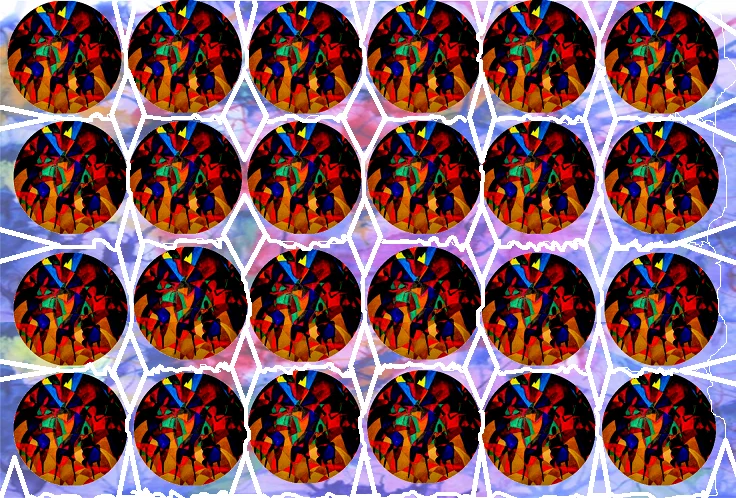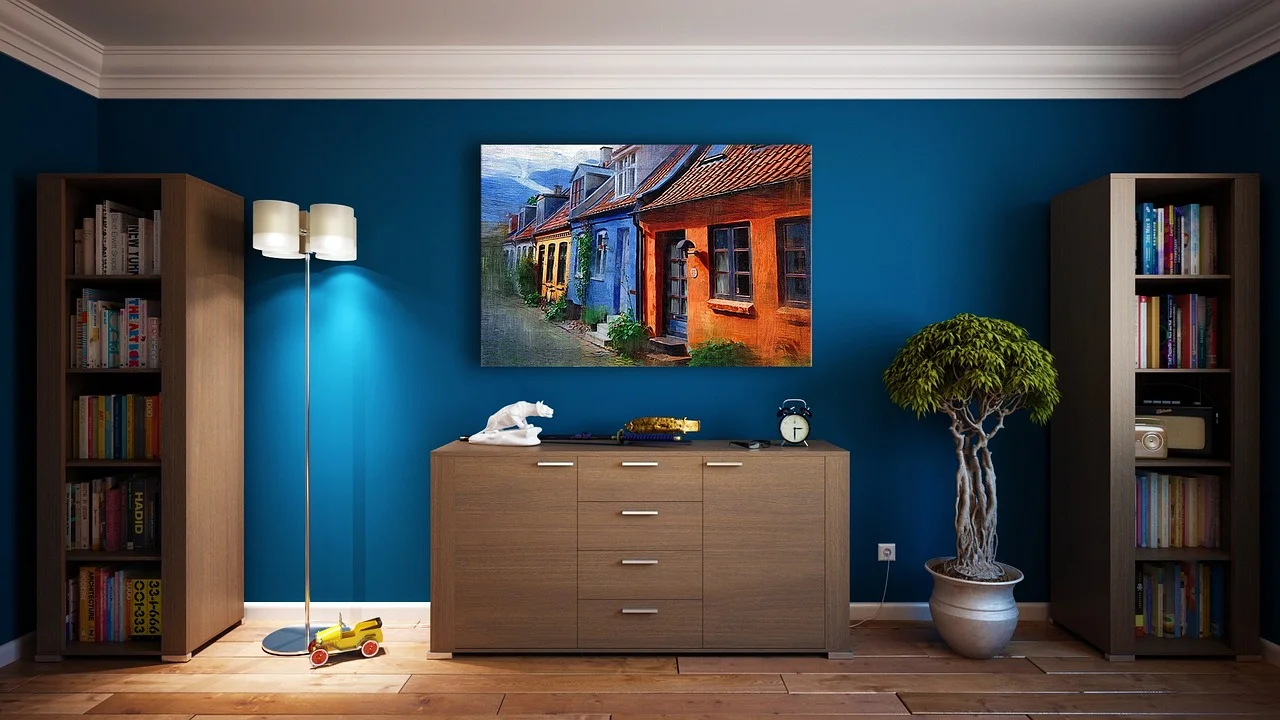Abstract Art Painting: A Comprehensive Exploration

Abstract art stands as a profound and transformative facet of artistic expression, transcending traditional norms in abstract art painting, sculpture, and realistic craftsmanship. This form of art diverges from the representation of objects in the visible world, focusing on dynamic elements like structure, colour, line, tone, and texture. Before delving into the intricate world of abstract art, it's crucial to trace its origins back to the 19th century.
Origins and Influences
The 19th century marked a period of intricately detailed artwork, often created for narrative purposes. Painters during this time explored the nuances of light and visual perception, challenging conventional ideas about art that emphasized imitation and admiration of beauty. The Romanticism era shifted the focus to the role of imagination and the unconscious as primary creative forces. This shift in perspective found resonance in Maurice Denis' 1890 statement: "It should be remembered that a picture, before being a war-horse, a nude, an anecdote, or the like, is essentially a flat surface covered with colours assembled in a certain order." This sentiment set the stage for the evolution of abstract art and found favour among Symbolist and Postimpressionist artists of the time.
The Pioneers of Abstract Art Painting
The major art movements of the early 20th century, including Fauvism, Expressionism, Cubism, and Futurism, highlighted the growing gap between art and natural appearances. Abstracting from visible forms or creating art without reference to the tangible world became a profound distinction in the years leading up to World War I. Visionary artists like Robert Delaunay,
Wassily Kandinsky, and
Kazimir Malevich played pivotal roles in embracing and championing fundamentally abstract art. Kandinsky, in particular, is often regarded as the first modern artist to paint purely abstract images in 1910â11.
Abstract Art Painting Between the Wars
Despite the initial enthusiasm for abstract art, the period between World Wars I and II proved challenging for the movement. It faced adversity in the form of authoritarian politics and renewed emphasis on imagery from art movements like Surrealism and socially critical Realism. Abstract art struggled to gain prominence during this turbulent time, but it laid the groundwork for a resurgence
post-World War II.
Resurgence with Abstract Expressionism
The aftermath of World War II witnessed the emergence of a robust American school of abstract painting known as Abstract Expressionism. This movement had a profound impact on the art world, challenging preconceived notions and ushering in a new era of acceptance for abstract art. The 1950s marked a turning point when abstract art became widely acknowledged and practised in both European and American painting and sculpture.
The Complexity of Abstract Art Painting
Abstract art, with its non-referential language, has the propensity to perplex some observers. However, for those who grasp its intricacies, abstract art holds undeniable value and achievements. Its journey from the rebellious stance against conventional representation to widespread acceptance signifies a transformative shift in the art world.
The Aesthetics of Abstraction
The aesthetics of abstract art delve into the core elements that define its beauty and significance. The interplay of structure, colour, line, tone, and texture creates a unique visual language that transcends the need for recognizable subjects. Abstract art invites viewers to explore the depths of their imagination, encouraging a subjective interpretation that goes beyond the confines of literal representation.
Abstract Art Painting Elements: Building Blocks of Expression
The foundational elements of abstract artâstructure, colour, line, tone, and textureâserve as the building blocks of expression. Each element contributes to the overall composition, guiding the viewer through a journey of visual exploration. Understanding these abstract elements is essential for appreciating the depth and complexity inherent in abstract artworks.
Structure: Beyond the Tangible
Structure in abstract art refers to the organization and arrangement of visual elements on a two-dimensional surface. Unlike representational art, where structure often mimics real-world objects, abstract art allows for the exploration of unconventional forms and compositions. Artists use structure to create a sense of balance, rhythm, and harmony within the artwork, guiding the viewer's gaze through a non-literal narrative.
Colour: A Vibrant Palette of Emotion
Colour holds immense significance in abstract art, serving as a powerful tool for conveying emotions and evoking reactions. Abstract artists utilize colour theory to create harmonious or contrasting palettes, influencing the overall mood of the artwork. The absence of representational constraints allows for a boundless exploration of colour, enabling artists to tap into the emotional and psychological impact of each hue.
Line: Expressive Gestures on Canvas
In abstract art, lines are not confined to delineating objects but become expressive gestures on the canvas. Artists use lines to create movement, rhythm, and energy within the composition. The freedom to explore various types of linesâstraight, curved, jaggedâopens up endless possibilities for visual expression. Lines in abstract art guide the viewer's eyes, creating a dynamic visual experience.
Tone: Shaping Light and Shadow
Tone, the variation of light and dark within an artwork, plays a crucial role in abstract art. Artists manipulate tones to create depth, three-dimensionality, and a sense of atmosphere. The absence of representational constraints allows for experimental use of tones, pushing the boundaries of traditional shading techniques. Abstract art invites viewers to appreciate the interplay of light and shadow in a non-literal context.
Texture: Invoking Sensory Engagement
Texture in abstract art transcends the visual realm, inviting viewers to engage their sense of touch. Artists experiment with various techniques and materials to create tactile surfaces that add depth and dimension to the artwork. Texture enhances the sensory experience, encouraging viewers to immerse themselves in the physicality of the artwork. Abstract art's embrace of diverse textures contributes to its rich and immersive nature.
The Evolution of Abstract Art Movements
The journey of abstract art is marked by the evolution of distinct movements, each contributing to its development and acceptance. Understanding these movements provides insight into the diverse approaches artists have taken to push the boundaries of artistic expression.
Fauvism: Embracing Colorful Expression
Fauvism, emerging in the early 20th century, was characterized by bold, vibrant colours and a departure from realistic colour representation. Artists like Henri Matisse and André Derain embraced the use of intense hues to evoke emotional responses, challenging traditional notions of colour usage in art. Fauvism laid the groundwork for the exploration of colour as a powerful means of expression in abstract art.
Expressionism: Conveying Emotion through Form
Expressionism, a movement that gained prominence in the early 20th century, focused on conveying raw emotion through distorted and exaggerated forms. Artists like Edvard Munch and Egon Schiele sought to express inner turmoil and subjective experiences, breaking away from realistic depictions. Expressionism played a pivotal role in shaping the expressive potential of abstract art.
Cubism: Fragmentation and Multiple Perspectives
Cubism, pioneered by Pablo Picasso and Georges Braque, emerged as a revolutionary movement in the early 20th century. It sought to represent the subject from multiple perspectives, breaking it
down into geometric shapes and facets. Cubist artworks challenged traditional notions of representation, paving the way for a more fragmented and abstract approach to depicting reality.
Futurism: Celebrating Dynamism and Technology
Futurism, an avant-garde movement founded by Filippo Tommaso Marinetti, glorified the speed, energy, and technological advancements of the modern world. Artists like Umberto Boccioni embraced dynamic compositions and the representation of motion, influencing the development of abstract art. Futurism's emphasis on capturing the essence of movement contributed to the evolving language of abstraction.
De Stijl: Embracing Geometric Abstraction
The De Stijl movement, founded by artists like Piet Mondrian, embraced geometric abstraction and a reductionist approach to artistic expression. Characterized by the use of primary colours and non-objective geometric forms, De Stijl sought to achieve a universal visual language. Mondrian's iconic grid
paintings became emblematic of the movement, influencing the trajectory of abstract art towards greater simplicity and purity.
Dadaism: Subverting Conventions through Absurdity
Dadaism, born out of disillusionment with societal norms and the aftermath of World War I, embraced absurdity and anti-art sentiments. Dada artists, including Marcel Duchamp, sought to subvert artistic conventions and challenge established notions of art. While not exclusively focused on abstraction, Dadaism's radical approach laid the groundwork for questioning traditional artistic boundaries, contributing to the broader context of abstract art.
Post-War Renaissance: Abstract Expressionism
The post-World War II era witnessed a renaissance in abstract art, particularly with the emergence of Abstract Expressionism. This movement, primarily centred in the United States, marked a departure from representational art and embraced spontaneous, gestural abstraction. Abstract Expressionist artists explored the depths of their emotions, creating artworks that captured the essence of their inner worlds.
The New York School and Gestural Abstraction
Abstract Expressionism found its home in the New York School, a group of avant-garde artists who sought to break away from traditional artistic conventions. Figures like Jackson Pollock, Willem de Kooning, and Mark Rothko championed gestural abstraction, employing techniques such as drip painting and expressive brushstrokes. The canvas became a battlefield for raw emotions, allowing artists to convey their innermost feelings without the constraints of representation.
Colour Field Painting and Minimalism
Within Abstract Expressionism, two significant offshoots emerged: Color Field Painting and Minimalism. Colour Field artists, including Helen Frankenthaler and Barnett Newman, focused on large expanses of colour to evoke emotional responses. Minimalist artists like Donald Judd and Frank Stella embraced simplicity, reducing art to its essential geometric forms. These divergent approaches within Abstract Expressionism expanded the spectrum of abstract art possibilities.
Impact on the Global Art Scene
Abstract Expressionism had a profound impact on the global art scene, influencing subsequent art movements and cementing the acceptance of abstract art as a legitimate form of expression. The movement's emphasis on individuality, emotion, and the act of creation laid the groundwork for the diverse array of abstract styles that followed.
Contemporary Perspectives on Abstract Art
As we navigate the complexities of the
contemporary art landscape, abstract art continues to evolve and adapt to new perspectives and approaches. Artists today draw inspiration from the rich history of abstract art movements while pushing the boundaries of creativity and expression.
Abstract Art in the Digital Age
The digital age has introduced new possibilities for abstract art, with artists exploring the intersection of technology and creativity. Digital tools allow for the manipulation of visual elements in unprecedented ways, offering artists a vast canvas for experimentation. The boundary between traditional and digital forms of abstract expression has become increasingly blurred, opening up avenues for innovative artistic endeavours.
Multidisciplinary Approaches to Abstraction
Contemporary artists often adopt multidisciplinary approaches to abstract art, incorporating elements from various mediums such as sculpture, installation, and performance. This interdisciplinary fusion allows for a more holistic and immersive experience, challenging traditional notions of artistic boundaries. The exploration of abstraction across diverse artistic disciplines reflects the dynamic and ever-evolving nature of contemporary abstract art.
Global Perspectives and Cultural Influences
The globalization of the art world has led to a rich tapestry of global perspectives and cultural influences in abstract art. Artists from diverse backgrounds draw upon their cultural heritage, creating artworks that reflect a fusion of traditions and contemporary expression. The intersection of different cultural narratives adds depth and complexity to the evolving language of abstract art on a global scale.
Conclusion: Abstract Art's Enduring Legacy
In conclusion, abstract art's enduring legacy is a testament to its transformative power within the artistic landscape. From its humble origins in the rebellious spirit of the 19th century to the global acceptance witnessed in contemporary art, abstract art has shaped and redefined the boundaries of creative expression.
The foundational elements of structure, colour, line, tone, and texture serve as the building blocks of this rich and diverse artistic language. The evolution of abstract art movements, from Fauvism to Abstract Expressionism, reflects the continual quest for innovation and individuality within the artistic community.
As we navigate the complexities of the contemporary art scene, abstract art continues to adapt, drawing inspiration from new technologies, multidisciplinary approaches, and global perspectives. The legacy of abstract art lies not only in its historical impact but also in its ability to inspire artists to push the boundaries of creativity and challenge the status quo.
Abstract art, with its non-referential language, invites viewers to engage in a subjective interpretation that transcends the confines of literal representation. For those who grasp its intricacies, abstract art holds undeniable value and achievements, solidifying its place as a dynamic and enduring force within the ever-evolving world of art.
About The Author
Hello, I'm Patrick Wilson — an entrepreneur, artist, and storyteller driven by curiosity and passion. Through this
blog, I explore and share meaningful content around a wide spectrum of lifestyle and success topics that matter to
everyday people looking to live better, earn more, and grow intentionally.
From building a personal brand and making money online through proven
digital strategies, to navigating the journey of personal finance and wealth-building — I bring
real-world insights and tools to help you take control of your financial future.
I also document my pursuit of a healthy, balanced life — sharing inspiration around
achieving fitness goals and living with purpose. As someone who appreciates both the aesthetic and
the soulful, I dive deep into fine art, cultural history, and the enriching
nuances of everyday lifestyle.
Whether I'm exploring breathtaking travel destinations across the globe or tending to the joys of
home and garden, I aim to bring beauty, clarity, and useful ideas to every post.
If you're passionate about growth — financially, creatively, or personally — this blog
is designed to inspire and support your journey.
Thanks for being here — let's grow together.

Monetize Your Blog Effortlessly with Magenet
Magenet empowers bloggers and site owners to earn passive income by seamlessly integrating contextual ads.
Whether you run a niche blog or a high-traffic site, Magenet provides a reliable way to turn your site into a
powerful income engine.
Start Earning with Magenet →

Trade Smarter with Olymp Trade – 10 Years of Innovation
Olymp Trade has spent over a decade building a powerful platform for modern traders. Whether you're just
starting or already experienced, you’ll find intuitive tools, educational resources, and a user-first design.
With a reputation for reliability, global reach, and a seamless mobile experience, Olymp Trade helps you
navigate the markets with clarity and confidence. Join millions who are making informed trades today.
Start Trading Now →


Comments